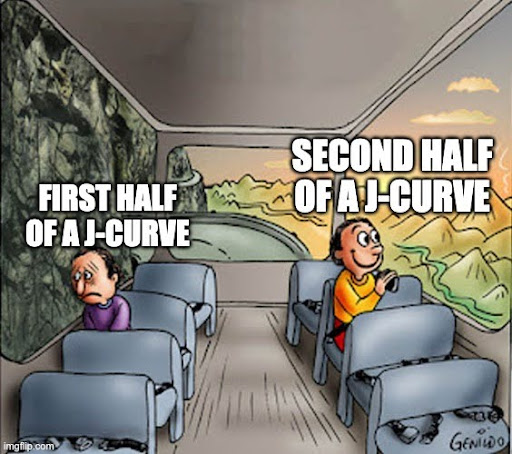
The attraction of investing in companies before they go public is simple: you can bank major gains if the projects succeed. The downside? Those gains are far from guaranteed. Venture capitalists and private equity firms have to kiss plenty of frogs before they find the proverbial prince.
But it’s not just VC firms anymore. Today, the private secondary market is more accessible than ever to everyday accredited investors. But this means many of those investors may have yet to know the lessons that the institutional ones learned the hard way.
If you're new to investing in pre-IPO companies, it's important to know what to expect and how to manage some of the risks. The J-curve is a common yardstick. It's a J-shaped graph that shows how private market investments can potentially post gains, even after initial losses.
Before we get into the J-curve, let's look at why investors might want to back early-stage companies.
SoftBank's Vision Fund invested $680 million in DoorDash during its initial phases, which meant it had a 25% stake in the company when it went public. When DoorDash IPO-ed in 2020, its shares soared. At that point, SoftBank's investment was worth just shy of $2 billion, according to Reuters.
They say a picture is worth a thousand words. But in this case, it's a number. That eye-watering 1,650% gain illustrates the appeal of investing in startups better than any words ever could.
Unfortunately, for early investors, every DoorDash success is counterbalanced by many more failed projects and dashed hopes. Harvard Business Review says more than two-thirds of startups never deliver a positive return to investors. Venture capitalists' portfolios will see gains of billions of dollars from successful projects, but those may be offset by projects that haven't yet achieved their potential — or collapse before they do.
As such, the Vision Fund's performance is hit and miss. In its most recent earnings report, SoftBank reported the fund had lost over 115 billion yen (about $780 million). The year before, it gained over 128 billion yen, but that was the first time it had profited since 2021.
The J-curve may help us understand why.
Startups typically go through several funding phases before going public, assuming they do at all. This begins with seed funding, which usually involves angel investors or crowdfunding sources. Next comes Series A investment, when venture capitalists may get involved. Series B and C are about funding growth and potentially preparing the firm for an IPO.
Hubtas, a crowdfunding research company, says the journey from seed company to stock market listing can take 7 to 10 years. In other words, some of those early-stage investors may wait a decade before they can realize any potential gains.
That’s where the J-curve comes in. Plotting the returns of the venture capitalists and private equity funds shows the startup journey from an investment perspective, and it often looks like the letter J.
Historically, in the initial investment period, the J often dips. Returns will usually be negative at first, because the fund is putting money into early-stage companies and might have to wait years before seeing any profits.
Then, as the companies mature, the fund can exit some of their investments, in what's known as the harvesting period. In an ideal world, this upswing creates the other half of the J — a sharp upward curve. In the case of some early-stage investments, like the aforementioned DoorDash example, that upswing can be very sharp indeed.
When we talk about pre-IPO investing, we tend to look at late-stage startups. These companies might be a couple of years away from going public, which may put them closer to the profitable end of the J-curve. They have already gone through several rounds of funding. Investors have a better feel for how the business is managed and makes money. There's still risk, but likely less than in early seed investments. Many less-viable businesses will already have failed.
However, with private investing more accessible than ever, accredited investors now have the opportunity to get in on the true ground floor. Secondary marketplaces like Augment* provide a platform to buy and sell shares of pre-IPO companies. With investors increasingly able to back startups earlier in their development, it is more important than ever to understand the possible trajectories of those investments — like the potential for sharp losses to proceed gains.
The growth of secondary marketplaces makes the J curve more relevant to everyday investors. They also have the potential to reshape it.
Fund managers may be able to shorten the time it takes to become profitable by investing in later-stage companies. They can also use the secondary market to exit investments without waiting for an IPO.
The J-curve was first observed in the 1970s, and many economists have accepted it as conventional wisdom for decades. Now, private secondary marketplaces are shaking up those old models and offering new opportunities to a wider range of investors.
*Securities transactions are executed on Augment Capital, LLC's ATS and offered through Augment Capital, LLC (member FINRA/SIPC).
Important Disclosures: Investing in private securities involves substantial risk, including the potential loss of principal. Private securities are typically illiquid, have limited pricing transparency, and often require longer holding periods. These investments are available exclusively to qualified accredited investors and offer no guarantee of returns. Additionally, past performance of private securities does not indicate or predict future results.
FOR ACCREDITED INVESTORS ONLY: Under federal securities laws, private market investments on this platform are available exclusively to Accredited Investors. Verification of status required before investing. Private investments involve significant risks including illiquidity, potential loss of principal, and limited disclosure requirements. "Augment" refers to Augment Markets, Inc. and its affiliates. Augment Markets, Inc. is a technology company offering software and data services, in addition to financial products and services through its wholly-owned but separately managed subsidiary, Augment Capital, LLC. Securities are offered by Augment Capital, LLC, member of FINRA / SIPC.